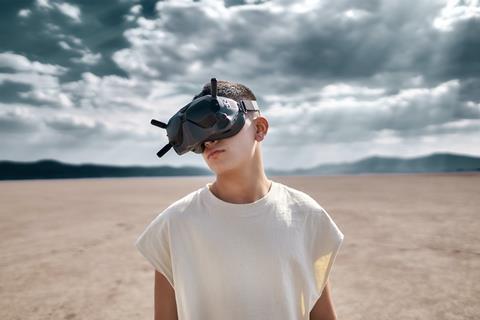The metaverse continues to be all things to all men, as the saying goes. Incorporating everything from VR to gaming, virtual worlds to IoT, and layering on AI and blockchain, it’s no wonder that the appeal is considerable, but real-world success (and indeed definition) has been lacking to date. Mark Mayne looks at the latest Metaverse moves to draw out some learnings so far, and the likely shape of things to come…
Metaverse: Bullish on VR
There’s no doubt that analyst firms remain bullish about the Metaverse in general, although which elements of the mix varies between firms, making comparison difficult. A recent report from Bloomberg Intelligence predicted that the metaverse will realise $615 billion in spending by 2030, driven by virtual and augmented reality adoption, itself spurred by rumours of the imminent launch of an Apple VR headset.

Mandeep Singh, BI Senior Industry Analyst (Technology), commented in a statement: “Metaverse offerings that leverage virtual reality (VR) and augmented reality (AR) devices for immersive 3D experiences beyond gaming – in areas such as e-commerce, concerts and education – have the potential to drive $615 billion in spending by 2030, our analysis suggests. VR/AR hardware and token- and ad-based revenue will be critical on the consumer side, while public-cloud infrastructure and VR/AR enterprise software and design will be key to laying the foundation for experiences.
Apple’s entry into this space with a new mixed-reality headset remains crucial to mainstream adoption. Industry revenue from the technology’s use for entertainment may be delayed until the VR/AR user base is at least 50-100 million.”
Separately, IDC has in the past predicted that AR/VR spend will accelerate to over $40 billion by 2030, up from around $4.3 billion in 2022. One key driver is the entertainment sector, where the prospect of creating shared virtual spaces where audiences can gather and experience content has seen an explosion in platforms vying for supremacy. These include Meta, STYLY, Pico, Spatial, Varjo, and a host of others.
Metaverse: AR benefits and revenue uplifts
Digging into the AR/VR/XR version of the metaverse reveals a particularly tempting combination of benefits from an entertainment and media perspective. For production houses reaching market saturation point with established brands and shows, the opportunity to reach new monetisable audiences in entirely new environments is one that can’t be ignored, especially when existing territory revenue streams have already been ‘banked’.

Cassandra Rosenthal, Co-founder and Co-CEO of Kaleidoco, an entertainment technology company, said that in her experience media businesses are still in the adoption phase, rather than getting too involved in the detail of revenue drivers.
“Staking their claim is more important [for businesses] at the moment. Monetisation will come later once we have mass adoption, but until that point, infrastructure and technology development are crucial. How we build this new world will determine the digital frontier’s safety, social, and business aspects.
There is a massive weight of responsibility to balance the race to launch new products with security and protection for the end users. The metaverse has a tremendous amount of potential. The question is, how are we going to use it?
“Opportunities for monetisation are vast and varied, but the primary focus is how and what we are building in a way that brings a positive experience to the end user.”
It is certainly the case that user experience will continue to be a central concern for media and entertainment companies tapping into the potential of the metaverse. One of the key battlegrounds of the moment is whether that experience should be an extension of an existing brand or entertainment property, or a separate one. There are arguments both ways - extending the existing experience risks simply diluting existing channels and engagement, while separating it creates a new set of challenges requiring additional resource, management and all the inevitable corollaries.
Tom Grogan, CEO of MDRxTech was keen to emphasise that frictionless integration into the user journey will be a central factor in success: “Media and tech companies should implement seamless integrations into users’ existing routines. Doing so eliminates the need for external purchases, such as headsets or downloads of extra applications.
“Instead, surprising and delighting users with hidden features and fun elements, such as Easter eggs, is more effective. Keep implementations well-maintained and frequently updated, and give users control to customise their avatars and vote on decisions.”
Read more NFTs & the Metaverse: Creative opportunities and future-facing businesses
This extension experience was clearly the thinking behind Paramount Global’s partnership with RECUR, which seeks to port key Paramount entertainment brands and characters to the metaverse. Last April a Star Trek NFT digital collection was dropped via Paramount.xyz, a portal where fans can buy, collect and trade NFTs as digital collectibles across Paramount’s portfolio of brands, including Paramount Pictures, Nickelodeon, Comedy Central, MTV, BET, CBS, Showtime Networks Inc.
Fans will be able to “build a community, engage with peers, and unlock new, innovative and interactive experiences”, according to the company. Interestingly, although the initial ‘minting’ sale of Star Trek Continuum lasted 24 hours, engagement with the platform has continued, racking up an all-time transaction total of $513,000 as fans buy and exchange their algorithmically-generated starships, with a 30-day volume of $5,600.
Metaverse: Immersive 3-D shared environments
David Shrier, Leading Futurist and Managing Member of the venture studio Visionary Future commented: “It’s important to remember that the Metaverse includes not only virtual reality but also other immersive 3-D shared environments. When you include such examples as Roblox, Minecraft and Fortnite, half a billion people are in the Metaverse. These lighter weight, virtual worlds serve a critical purpose of accessibility. Today, there are two major barriers to success in a purely virtual environment.

“One is hardware, where the existing devices are expensive and a little clunky. This will change over the next three to five years, I point to the new mixed reality products from Ray-Ban and from Apple. The other major obstacle is bandwidth. For a seamless virtual environment, you need 2 Gb/s, and in a city like London, the average downlink is 50 Mb/s (40 times slower).”
Shrier certainly has a point - Roblox, Minecraft and Fortnite combined represent enormous, highly engaged and - overwhelmingly - young audiences. Roblox hit 208 million global downloads 2022 alone, making it the third most popular game overall globally among iOS and Google Play devices, according to Finbold. To put that into context, the entire population of the UK would have to download the game just over three times each to hit that figure.
Meanwhile, Fortnite claims 400 million registered users, and a consistent monthly active player base of around 80 million. Minecraft is thought to have an active monthly player base of around 141 million in 2021. The lure of engaging this type of actively-engaged audience is unsurprisingly considerable.
Tom Grogan, CEO of MDRxTech continued: “For existing brands, the Metaverse offers an opportunity to grow rather than radically change. Brands can evolve in the Metaverse by crafting immersive stories and forging meaningful connections and experiences to reach their next level of development. Major retailers, for instance, can leverage the Metaverse to create more experiential in-store visits and bring a new physical dimension to their web pages.”
The same applies to broadcasters, as ITV Studios is demonstrating with the launch of immersive virtual experience “The Voice Studios” in May 2023, based around four-time Emmy Award-winning musical competition series “The Voice”. The new Decentraland-based experience allows fans to create their own music, show off their dancing skills, compete in Battle rounds, test their musical knowledge and audition to be on an upcoming season of the series. A significant aspect of the experience is a NBC metaverse fan zone, where Voice-themed MetaMerch can be won. The more content and gameplay fans participate in, the more features they can unlock.
Lucie Stoffers, Head of Brand Licensing, Global Partnerships, ITV Studios, said in a statement: “After the very successful first pop-up area within the Decentraland Metaverse Music Festival, we are very excited to continue this journey together with VBG bringing The Voice Studios to Decentraland. And while very few people get to be in a studio where ‘The Voice’ is being recorded, let alone receive a tailored gift from their favourite Coach, it will now be possible for all fans to get access and have fun in this new immersive experience.”
Metaverse: Challenges are still significant
It’s fair to say that the metaverse faces many different challenges, from the purely technical to the perceptual, as well as many in between. Even the withering level of Meta’s investment - metaverse division Reality Labs clocked up a two-year cumulative loss of nearly $24 billion, including $13.7 billion in 2022 - has not resulted in a smooth and easy product rollout to soothe investors.

It’s fair to say that other media and technology firms should tread carefully, however tempting the promises of the metaverse might appear. Grogan warned: “Businesses must implement a well-defined strategy, considering their return on investment and how to measure it. There must be a clear communications plan, with a response strategy to manage potential reputational risks. Companies should also seek out reliable reputable vendors and get lawyers involved in every project stage. It’s also wise to consider issues like online harm, dark patterns, and consumer protection. Moreover, before launching any project, third-party penetration tests and audits should be conducted to ensure compliance.”
Whatever the future of the metaverse proves to be, it’s fairly certain that it will be many things to many people and businesses rather than one homogenous technical blob. The numerous strands that can be woven together into ‘the metaverse’ are all developing independently in different directions, finding differing levels of traction in different sectors - the metaverse will remain all things to all men, at least for the foreseeable future.
Read more The metaverse: Unpicking the potential for broadcasting
























No comments yet